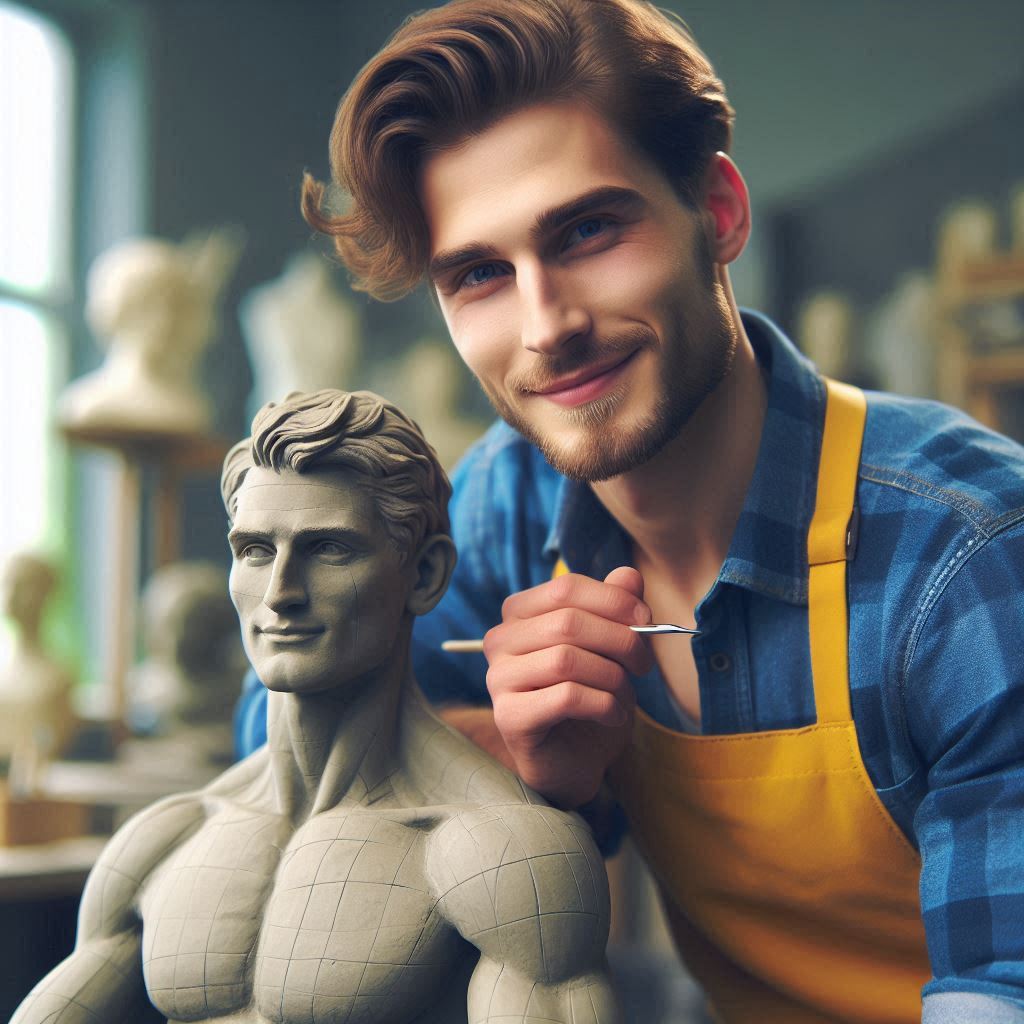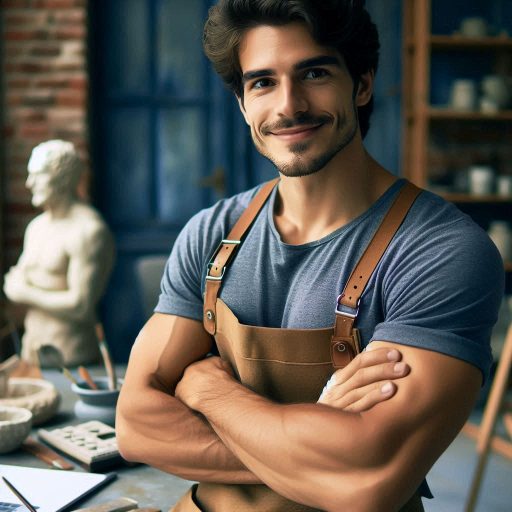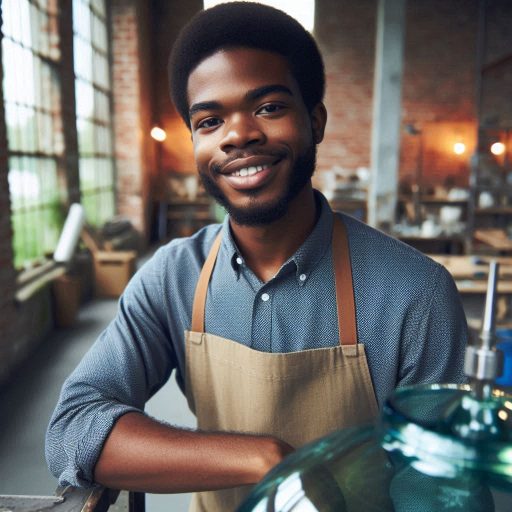Introduction
Becoming a sculptor requires a unique set of skills, tools, and training to bring creativity to life.
A sculptor is an artist who creates three-dimensional works of art using various materials like clay, stone, or metal.
Their skills in sculpting, understanding of tools, and continuous training play a vital role in shaping their career.
To excel in sculpting, one must possess creativity, attention to detail, and problem-solving skills to transform ideas into reality.
Creativity allows sculptors to envision unique designs, while attention to detail ensures the precision required in their work.
Sculptors encounter challenges during the creation process, and they need problem-solving skills to overcome obstacles and refine their art.
Essential tools and materials used by sculptors
Different types of tools
Sculptors require a variety of tools and materials to bring their creative vision to life.
Here are some essential items used by sculptors:
- Clay: A malleable material often used for modeling and creating maquettes before working on the final sculpture.
- Stone: Harder materials like marble, granite, or alabaster are commonly used for sculpting enduring pieces.
- Wood: Softwoods like pine or hardwoods like walnut offer versatility in sculpting techniques.
- Metal: Metals such as bronze, steel, or aluminum can be used for casting sculptures or creating intricate details.
- Plaster: This material is often used for creating molds and as a casting material for sculptures.
- Modeling tools: Various tools like sculpting knives, spatulas, and loop tools are essential for shaping clay or carving materials.
- Chisels: Chisels with different shapes and sizes are crucial for carving stone or wood with precision.
- Hammers: Different types of hammers, including mallets and stone hammers, are necessary for sculpting hard materials.
- Rasps: These tools help sculptors refine their work by smoothing rough surfaces and shaping intricate details.
- Calipers: Used for measuring and checking proportions, calipers are indispensable for achieving accuracy in sculpture.
The Significance of Quality Tools in Sculpting
Quality tools play a crucial role in the sculpting process as they directly impact the precision and detail of the final piece.
Here’s why using high-quality tools is essential for sculptors:
- Precision: Quality tools allow sculptors to make precise cuts, carvings, and detailing, resulting in a more refined and polished sculpture.
- Durability: High-quality tools are built to last, ensuring that sculptors can rely on them for consistent performance over time.
- Efficiency: Well-crafted tools streamline the sculpting process, making it easier for artists to achieve their desired results without unnecessary effort.
- Detail: Fine detailing and intricate work require tools that can handle delicate movements with accuracy, something that quality tools can provide.
- Ergonomics: Comfort and ergonomics are essential for sculptors who spend hours working on their pieces, and quality tools offer better grip and control.
- Professionalism: Using quality tools not only enhances the quality of the sculpture but also reflects the dedication and professionalism of the artist.
- Investment: While quality tools may come at a higher cost, they are a worthwhile investment for sculptors who seek to create exceptional pieces that stand the test of time.
In essence, having the right tools and materials is crucial for sculptors to bring their creative ideas to fruition with precision, detail, and artistic excellence.
By investing in quality tools and mastering their use, sculptors can elevate their craft and create masterful works of art.
Read: The Sculptor‘s Journey: Pathways to an Artistic Career
Exploring Training Options for Aspiring Sculptors
Aspiring sculptors have several training options available to them, each with its own unique benefits and opportunities.
Traditional Training Methods
- Apprenticeships: One traditional way to learn sculpting is through apprenticeships with experienced artists.
This hands-on approach allows aspiring sculptors to learn directly from masters in the field, gaining valuable skills and knowledge. - Art Schools: Another common route for aspiring sculptors is to attend art schools or institutions that offer formal education in sculpture.
These programs provide structured learning environments where students can explore various techniques and styles under the guidance of experienced instructors.
Benefits of Formal Education in Sculpture
- Learning from Experienced Instructors: One of the main benefits of formal education in sculpture is the opportunity to learn from experienced instructors who can provide valuable feedback and guidance on your work.
These mentors can help you develop your skills and push you to explore new artistic horizons. - Access to Studio Space and Equipment: Many art schools and institutions provide students with access to studio space, equipment, and tools needed to create sculptures.
This access allows aspiring sculptors to experiment with different materials and techniques, helping them hone their craft and develop their unique artistic style. - Networking Opportunities: Formal education in sculpture also offers networking opportunities with other artists, industry professionals, and art enthusiasts.
Building connections within the art community can open doors to exhibitions, collaborations, and potential career opportunities in the future. - Critique and Feedback: Another benefit of formal education is the opportunity to receive constructive criticism and feedback on your work.
Critiques from instructors and peers can help you identify areas for improvement and grow as an artist, pushing you to refine your skills and develop a stronger artistic voice.
Overall, whether you choose to pursue a traditional apprenticeship or enroll in an art school program, formal education in sculpture can provide you with the necessary skills, tools, and training to embark on a successful career as a sculptor.
Read: The Artist‘s Guide to Printmaking Supplies

Tips for self-taught sculptors
When it comes to becoming a sculptor, whether you are self-taught or seeking formal training, there are certain skills, tools, and resources you need to consider.
In this section, we will provide tips for self-taught sculptors, suggest resources for learning sculpting techniques, and encourage practicing regularly and seeking feedback from other artists.
- Start with simple materials like clay or wood to practice basic sculpting techniques.
- Study the work of renowned sculptors to understand different styles and approaches.
- Experiment with various tools and techniques to develop your unique artistic voice.
- Join online forums or communities to connect with other sculptors and learn from their experiences.
- Attend workshops or classes to learn new skills and techniques from experienced artists.
Resources for Learning Sculpting Techniques
- Online tutorials on platforms like YouTube can provide step-by-step guidance on different sculpting methods.
- Books by acclaimed sculptors or art instructors offer detailed insights into sculpting processes and techniques.
- Art schools or community colleges may offer courses specifically focused on sculpting for those looking for formal training.
- Visiting museums and galleries to study sculptures in person can provide inspiration and new ideas for your own work.
- Consider investing in specialized tools like sculpting knives, clay modeling tools, or armatures to improve your craft.
Practicing Regularly and Seeking Feedback
- Set aside dedicated time each day or week to work on your sculpting projects and hone your skills.
- Challenge yourself by taking on new subjects or experimenting with different materials to expand your artistic repertoire.
- Seek feedback from fellow sculptors or art instructors to receive constructive criticism and improve your work.
- Attend art openings, exhibitions, or art fairs to showcase your sculptures and network with other artists in the community.
- Document your progress and growth as a sculptor by keeping a sketchbook or portfolio of your work for self-reflection and improvement.
By following these tips, utilizing resources for learning sculpting techniques, and committing to regular practice and feedback, you can enhance your skills as a sculptor and continue to grow and evolve as an artist.
Read: Printmaking: Combining Traditional and Digital
Transform Your Career Today
Unlock a personalized career strategy that drives real results. Get tailored advice and a roadmap designed just for you.
Start NowImportance of gaining practical experience in sculpting
Significance of Gaining Practical Experience in Sculpting
- Hands-on experience helps develop skills effectively.
- Practice allows for experimentation and learning from mistakes.
- Working with different materials enhances expertise.
- Practical experience builds confidence in one’s artistic abilities.
- Allows sculptors to understand the nuances of sculpting.
Recommendations for Artist Participation
- Art competitions provide exposure and recognition.
- Exhibitions showcase work to a wider audience.
- Workshops offer learning opportunities and skill enhancement.
- Participation in events helps in networking with art enthusiasts.
- Feedback received helps in improving sculpting techniques.
Value of Networking and Mentorship
- Networking exposes sculptors to new opportunities and collaborations.
- Mentorship provides guidance and insights from experienced artists.
- Connections with other artists lead to shared knowledge and resources.
- Collaborations with peers can inspire and push boundaries creatively.
- Mentorship nurtures growth and development of artistic skills.
Read: Exploring Cultural Influences in Printmaking
Challenges Faced by Sculptors in Their Career
Addressing Limited Job Opportunities
One of the biggest challenges for sculptors is the limited job opportunities available in the industry.
It can be difficult to find consistent work, especially for those who are just starting out in their careers.
To overcome this challenge, sculptors should consider diversifying their skills and exploring different avenues for showcasing their work.
This could include participating in art fairs, collaborating with other artists, or even teaching sculpting classes to generate additional income.
Dealing with Financial Instability
Financial instability is another common issue that sculptors face.
Since sculpting is often considered a niche art form, it can be challenging to make a steady income solely from this profession.
To mitigate this challenge, sculptors should explore alternative income sources such as selling smaller pieces of art online, offering commission-based work, or even taking up part-time jobs to supplement their earnings.
Managing Physical Strain
The physical demands of sculpting can take a toll on the body, leading to fatigue and potential injuries.
To prevent burnout and ensure longevity in their careers, sculptors should prioritize self-care practices such as regular exercise, proper ergonomics in their workspace, and taking breaks to rest and recharge.
It is essential to listen to one’s body and seek medical attention if experiencing any physical discomfort.
In a nutshell, sculptors face a unique set of challenges in their career, ranging from limited job opportunities to financial instability and physical strain.
By diversifying their skills, exploring alternative income sources, and prioritizing self-care, sculptors can overcome these hurdles and thrive in their artistic pursuits.
See Related Content: The Future of Digital Fabrication in Furniture Design
Conclusion
Becoming a sculptor requires dedication, patience, and a willingness to learn.
Practice, experimentation, and honing your craft are essential components.
Having the right tools and training will help you achieve your artistic goals.
Remember to stay inspired, continue learning, and never give up on your passion for sculpting.
By staying committed and pushing through challenges, you can reach new heights in your artistic journey.
Showcase Your Business Today
Reach thousands of readers actively exploring professional services. Publish your business profile and grow your audience now.
Publish NowSo, go ahead, pick up your tools, and create something beautiful today!
[E-Books for Sale]
The Big Book of 500 High-Paying Jobs in America: Unlock Your Earning Potential
$19.99 • 500 High-Paying Jobs • 330 pages
Explore 500 high-paying jobs in America and learn how to boost your career, earn more, and achieve success!
See All 500 High-Paying Jobs of this E-Book
1001 Professions Without a Degree: High-Paying American Jobs You Can Start Now
$19.99 • 1001 Professions Without a Degree • 174 pages
Discover 1001 high-paying jobs without a degree! Unlock career tips, skills, and success strategies for just $19.99!




